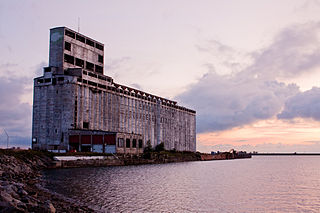
A grain elevator is an agrarian facility complex designed to stockpile or store grain. In the grain trade, the term "grain elevator" also describes a tower containing a bucket elevator or a pneumatic conveyor, which scoops up grain from a lower level and deposits it in a silo or other storage facility.
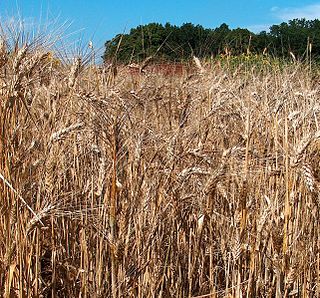
Durum wheat, also called pasta wheat or macaroni wheat, is a tetraploid species of wheat. It is the second most cultivated species of wheat after common wheat, although it represents only 5% to 8% of global wheat production. It was developed by artificial selection of the domesticated emmer wheat strains formerly grown in Central Europe and the Near East around 7000 BC, which developed a naked, free-threshing form. Like emmer, durum wheat is awned. It is the predominant wheat that grows in the Middle East.

Watson's Mill is an historic flour and gristmill in Manotick, Ontario, Canada. It is the only working museum in the Ottawa area and one of the very few operating industrial grist mills in North America. Watson's Mill still sells stone-ground whole wheat flour which is made on site. The mill is also well known for its ghost Annabelle. The legend is that Ann Currier, wife of Joseph, haunts the mill, following her death in a tragic accident there in 1861. Watson's Mill is Manotick's most recognized landmark. Its image is used as a symbol for the village.

York is the oldest inland town in Western Australia, situated on the Avon River, 97 kilometres (60 mi) east of Perth in the Wheatbelt, on Ballardong Nyoongar land, and is the seat of the Shire of York.
Riceland Foods, Inc. is a farmer-owned agricultural marketing cooperative and the world's largest miller and marketer of rice. The company was founded in 1921 with headquarters in Stuttgart, Arkansas. Riceland owns and operates seven rice mills, including the largest rice mill in the world, located in Jonesboro, Arkansas. More than two-thirds of Riceland's business is delivering, milling, storing, marketing and distributing rice.
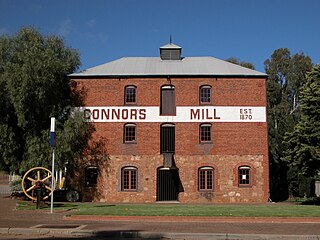
Connor's Mill is a steam driven flour mill located on Stirling Terrace in Toodyay, Western Australia.
Wheat middlings are the product of the wheat milling process that is not flour. A good source of protein, fiber, phosphorus, and other nutrients, they are used to produce foods like pasta, breakfast cereals, puddings, and couscous for humans, as well as fodder for livestock and pets. They are also being researched for use as a biofuel.

Mill City Museum is a Minnesota Historical Society museum in Minneapolis. It opened in 2003 built in the ruins of the Washburn "A" Mill next to Mill Ruins Park on the banks of the Mississippi River. The museum focuses on the founding and growth of Minneapolis, especially flour milling and the other industries that used hydropower from Saint Anthony Falls.
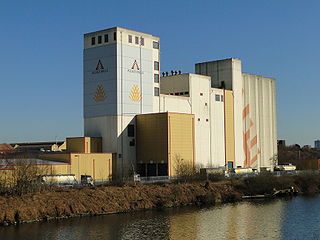
A gristmill grinds cereal grain into flour and middlings. The term can refer to either the grinding mechanism or the building that holds it. Grist is grain that has been separated from its chaff in preparation for grinding.
A Unifine mill is a single one-pass impact milling system which produces ultrafine-milled whole-grain wheat flour that requires no grain pre-treatment and no screening of the flour. Like the grist or stone mills that had dominated the flour industry for centuries, the bran, germ, and endosperm elements of grain are processed into a nutritious whole wheat flour in one step. Consumers had accepted whole wheat products produced by grist or stone mills. The flour produced by these mills was quite coarse as they included the bran and the germ elements of the grain.

CBH grain receival points are grain silos spread around Western Australia, primarily in the wheatbelt region. Historically they have been linked with the wheatbelt railway lines, and the transport of grain to ports for export.
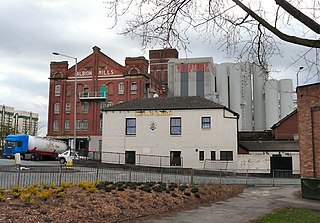
Nelstrops Albion Flour Mills, also known as Nelstrop Albion Corn Mill, Nelstrop's Flour Mill or Albion Mills, is a corn mill in Heaton Norris, Stockport, England. It is at the top of Lancashire Hill, on the roundabout next to the Navigation Inn. Nelstrops, the company which operates the mills, is one of the leading producers of flour in the United Kingdom.

Flour Mill is a heritage-listed former mill at 231 Brisbane Street, Ipswich, City of Ipswich, Queensland, Australia. It was designed by George Brockwell Gill and built from 1901 to 1902. It is also known as Bridal Mill, F.W. Johnson and Sons Motor Showroom, and Old Flour Mill. It was added to the Queensland Heritage Register on 21 October 1992.

Carew Tidal Mill, also called the French Mill, is a corn mill in Pembrokeshire, Wales, powered by tidal water. It was built around 1801 just west of Carew Castle, and replaced a much older mill in the same location. The mill pond fills through open flood gates as the tide comes in. The gates are closed at high tide, and the pond drains through sluices under the mill as the tide falls, driving two undershot water wheels. It is the only intact mill of this type in Wales. It was abandoned in 1937, was restored in 1972, and now houses a museum.

Avon Terrace it is the main street of the town of York, Western Australia, and is lined with heritage buildings.

The Rolandmühle in Bremen is an industrial grain mill that is one of the most important private production facilities in the harbour of Bremen. The company has about 100 employees and processes 350,000 tons of grain into flour annually for commercial and industrial use. Both imported and regionally grown grain are processed. The products have been supplied to both regional and export customers.

Dinsdale's Shoe Emporium is a heritage-listed building on Avon Terrace in York, Western Australia, constructed by a former mayor.

The Corowa Flour Mill is a heritage-listed former flour mill and now tourist attraction at Steel Street, Corowa, Federation Council, New South Wales, Australia. It is also known as the Corowa Flour Mill and site. It was added to the New South Wales State Heritage Register on 2 April 1999.
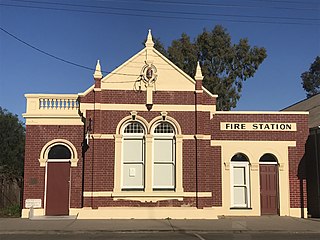
The York Fire Station is a single-storey red brick building originally constructed for the York Municipal Council as Council Chambers in 1897, in York, Western Australia.
John Henry Monger Snr (1802–1867) arrived in Western Australia as an assisted migrant in 1829. After a short period running a mill at what became Lake Monger, he established a hotel and store in York and went on to become one of the richest men in the colony.

















